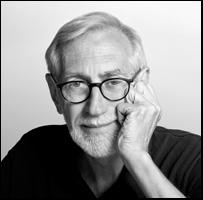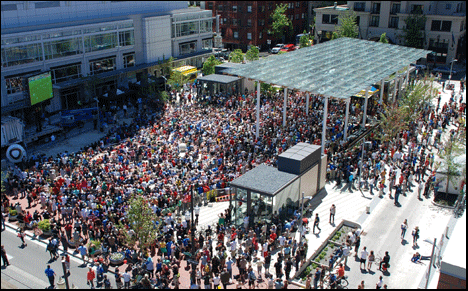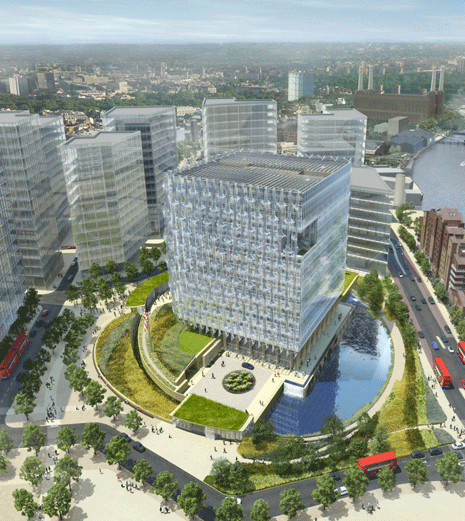Landscape architect Laurie Olin says that to design well you have to be interested in how people behave. Johanna Hoffman gets in-depth with Olin about his design process.
 When I first meet Laurie Olin – one of the foremost American landscape architects of the last half-century – at his Philadelphia offices, he is the urbane gentleman personified. His crisp bow ties and calm demeanor would fit well in the halls of Harvard, where indeed he served as chair of the landscape architecture program for several years. Just don't mistake him for the average dignified professor.
When I first meet Laurie Olin – one of the foremost American landscape architects of the last half-century – at his Philadelphia offices, he is the urbane gentleman personified. His crisp bow ties and calm demeanor would fit well in the halls of Harvard, where indeed he served as chair of the landscape architecture program for several years. Just don't mistake him for the average dignified professor.
An artist since his childhood years spent in pre-statehood Alaska, a self-professed raging liberal, and a seemingly insatiable student of human character, his designs create places that enhance life. For Olin and his partners, design is a tool that works best when it appeals to human tendencies across time. As such, his projects – from the high-profile restoration of NYC's Bryant Park to the rooftop meadow at the Church of Jesus Christ of Later Day Saints Conference Center in Salt Lake City – have an ageless quality. Planned with an understanding of the time and place in which they are made, Olin projects are spaces that serve well into the future.
Johanna Hoffman spoke with Olin about his work and his process.
Social issues play a big role in your work. What kind of process do you go through to spacialize social factors in a new project?
There's no specific process, really. The process of design is really all about asking yourself, "Where am I?" "What's the nature of the this place?" And the answer's always different.
A large part of designing is becoming a student of people. To design well you have to be interested in and learn about how people behave. For instance, humans really are the most devious and gregarious of the four great apes – the chimp, the gorilla and so on. We love to be together and watch other humans eat. So the work is in large part about designing nice places for those kinds of things to occur. Our designs are how we show what we've learned.

What are your most important goals in pursuing landscape architecture?
Well the first, to borrow a medical term, is 'do no harm.' No matter how you approach a project, you have to do what's appropriate to the particular place and time.
And if we start to talk about social issues, we usually in this day and age start talking about sustainability. When we talk about sustainability we end up talking about ecology. So for me, landscape architecture, social issues, and the environment are all inseparable.
But when it comes to design, Weber, who was at Harvard back when I was there, said something at a meeting that I very much agree with. He said 'The whole world is a homogenous equation but some issues are more important than others.' And it's true. Most things are important but human use of a site trumps everything. The most important goals we strive in design for are things like health, equity, meaning, spirit. Pretty rote, I know, but there it is.
In the spirit of achieving those types of goals, I make a point of introducing attributes of nature into highly urban social spaces. It's not about mimicking. Attempting to mimic nature is just pathetic. But we can invite nature in -- the movement, the texture, the color of it. Give me some of the stimuli of the John Muir trail when I'm in Manhattan! The great artists and designers have always done those things.
How did growing up in Alaska affect your view of nature?
Alaska is important and influential to me because it's the home of my childhood. I have a deep love for natural environments and processes because I grew up in them. We lived outside of Fairbanks in the interior of Alaska when it was still a territory, which means I kind of grew up still in the 19th century.
Living there had a big effect on my sense of scale and proportion – I can't stand small and ditzy things. Nature is grand and profligate and intimidating but also generous. Where I grew up, death was common -- for trees, people, everything. There were floods all the time, and volcanoes went off regularly. It was all natural. So nature, to me, is beautiful but I think of it in a more Hegelian way. My ideas about nature are hugely unsentimental. Romantic maybe, but unsentimental.
I've read that you look at cities as ecological analogs. What are the most important analogies you find between natural and built environments?
Well, when I first came down to the States, as we said in Alaska, I thought cities were wonderful. I went to Seattle first, and later to Chicago, to San Francisco, and so on, and I was continually amazed. Cities seemed like forests to me, so rich, so merciless, so redundant, and without any one person in charge. Cities are as wild as the wilderness in that way. Like any ecological landscape, they keep morphing, because cities really are landscapes – they're just urban landscapes.
I've always been puzzled by people who think of us as separate from nature. We're in it all the time. Yes, humans sometimes get egoistic and loose track of our place in the context of things, but that doesn't change the fact that we are all part of nature, that even things as seemingly unnatural as this light-bulb are members of nature's continuum.

There's a promise of cities as a wonderful habitat. They struck me as a challenge, as a design problem. When I eventually saw places like Paris and Rome, I discovered how great they could be. Through seeing the world, I began to realize that the only way to save things that I valued -- like wilderness -- was to make cities of value, to design spaces that would make people happy to live in density.
In 1939, the cultural anthropologist Claude Levi Strauss said, ‘The city is not an architectural problem; it's a cultural landscape.' And it's true. The issues of human habitation in cities will be with us indefinitely.
You're a gifted artist. Why choose to go into landscape architecture rather than pursue the fine arts?
I'm a builder at heart, and I'm really interested in people. Landscape architecture integrates those various aspects of my personality and interests. The remarkable thing is that most people can't even see its place in the world. (Noted practitioner Ian) McHarg used to say "fish would be the last to discover water," and it's true – because we live in the products of landscape architecture, it's often difficult for us to acknowledge its presence and effect.
It's also a profession that allows for more flexibility than some others, because much of landscape architecture is based on acknowledging humanity's place in nature. James Corner (principal of Field Operations and Chair of the PennDesign Landscape Architecture Department) said the other day that ‘landscape architects are control freaks who know how to let go.' And I agree.
One thing I've noticed about your designs is the way many of them feel as if they've been in place a long time, even if they're recent works. How do you think history influences your work?
History's really a remarkable thing if you're not afraid of it. If you don't know your history you are an empty vessel. But if you do, you're pretty well equipped for most things. Each phase of history lays down it's view of the world in its respective layer; each generation has to be able to do so.
But in order to do your layer well, you better know the other layers. There's no such thing as a blank slate. To do it well, knowing the history of the medium is essential.
How do you envision landscape architecture progressing in the future?
No one knows the answer to that question. The future is usually a certain extension of the present; in that way, a lot about the future is already here.
What's certain is that we have a global environmental crisis, about water, air quality, loss of habitat. And it's happening everywhere, especially in less wealthy nations. Population growth is exacerbating the issue.
These things lead to inevitable conflict, within and between societies, that are happening already. They also lead to extreme, unsustainable types of growth in cities. Right now, in China alone, there are over a dozen cities each larger than New York. People in those kinds of situation are now living in environments that don't resemble traditional cities at all, that don't provide for the functions that humans have required for generations.
The question of the present and future is what kind of people will those growing up in such environments be like? I think landscape architecture is a discipline that is and will continue to address those questions.
Johanna Hoffman is a freelance writer and environmental planning student at UC Berkeley's College of Environmental Design.

Depopulation Patterns Get Weird
A recent ranking of “declining” cities heavily features some of the most expensive cities in the country — including New York City and a half-dozen in the San Francisco Bay Area.

California Exodus: Population Drops Below 39 Million
Never mind the 40 million that demographers predicted the Golden State would reach by 2018. The state's population dipped below 39 million to 38.965 million last July, according to Census data released in March, the lowest since 2015.

Chicago to Turn High-Rise Offices into Housing
Four commercial buildings in the Chicago Loop have been approved for redevelopment into housing in a bid to revitalize the city’s downtown post-pandemic.

EV Infrastructure Booming in Suburbs, Cities Lag Behind
A lack of access to charging infrastructure is holding back EV adoption in many US cities.

Seattle Road Safety Advocates Say Transportation Levy Perpetuates Car-Centric Status Quo
Critics of a proposed $1.3 billion transportation levy say the package isn’t enough to keep up with inflation and rising costs and fails to support a shift away from car-oriented infrastructure.

Appeals Court: California Emissions Standards Upheld
The U.S. Environmental Protection Agency and the California Air Resources Board, the nation's two most powerful environmental regulatory agencies, won an important round in federal court last week. But the emissions standards battle may not be over.
Barrett Planning Group LLC
City of Cleburne
KTUA Planning and Landscape Architecture
HUD's Office of Policy Development and Research
Mpact Transit + Community
HUD's Office of Policy Development and Research
City of Universal City TX
ULI Northwest Arkansas
City of Laramie, Wyoming
Write for Planetizen
Urban Design for Planners 1: Software Tools
This six-course series explores essential urban design concepts using open source software and equips planners with the tools they need to participate fully in the urban design process.
Planning for Universal Design
Learn the tools for implementing Universal Design in planning regulations.




















